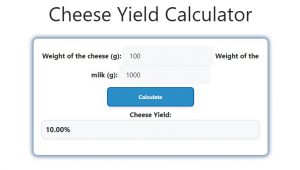About Cheese Yield Calculator (Formula)
The Cheese Yield Calculator is a vital tool in the dairy industry, specifically designed to help cheese makers evaluate the efficiency of their cheese production processes. Understanding the yield from milk to cheese is essential for optimizing production, managing costs, and ensuring quality. This calculator allows cheese producers to quantify how much cheese can be produced from a given weight of milk, enabling them to make informed decisions regarding their production methods. This article will explain the formula, guide you on how to use the calculator, provide a practical example, and answer frequently asked questions about cheese yield.
Formula
The formula for calculating cheese yield (CY) is:
Cheese Yield (CY) = (Weight of Cheese (WC) / Weight of Milk (WM)) * 100
Where:
- CY is the cheese yield percentage.
- WC is the weight of the cheese produced.
- WM is the weight of the milk used.
How to Use
Using the Cheese Yield Calculator is simple. Follow these steps:
- Gather Your Data: Obtain the weight of the cheese produced (WC) and the weight of the milk used (WM).
- Input the Values: Enter these values into the calculator.
- Calculate Cheese Yield: The calculator will apply the formula to determine the cheese yield percentage (CY).
Example
Suppose a cheese producer starts with 1,000 kilograms of milk and produces 100 kilograms of cheese.
Using the formula:
Cheese Yield (CY) = (Weight of Cheese (WC) / Weight of Milk (WM)) * 100
Cheese Yield (CY) = (100 / 1000) * 100
Cheese Yield (CY) = 0.1 * 100
Cheese Yield (CY) = 10%
In this example, the cheese yield would be 10%, indicating that 10% of the milk weight is converted into cheese.

FAQs
- What is a Cheese Yield Calculator?
It is a tool that helps determine the percentage of cheese produced from a specific amount of milk. - Why is cheese yield important?
It allows cheese makers to evaluate the efficiency of their production processes and manage costs effectively. - How is cheese yield calculated?
By dividing the weight of cheese produced by the weight of milk used and multiplying by 100 to get a percentage. - Can the calculator be used for all types of cheese?
Yes, the calculator can be applied to various cheese types as long as the relevant weights are known. - What is a good cheese yield percentage?
This varies by cheese type, but generally, higher yields indicate more efficient production. - How does moisture content affect cheese yield?
Higher moisture content in cheese typically results in lower yield percentages since more weight is lost during production. - What factors influence cheese yield?
Factors include milk quality, processing methods, and the type of cheese being produced. - Can this calculator help reduce waste?
Yes, by analyzing yield, producers can optimize their processes and minimize waste. - Is the Cheese Yield Calculator available online?
Many online tools and applications provide cheese yield calculation functionalities. - How can I improve my cheese yield?
Improve quality control during production and optimize the processing techniques. - Do I need specific equipment to measure cheese and milk weights?
Basic scales that can accurately measure weight will suffice for both cheese and milk. - Can I use the calculator for other dairy products?
While it’s designed for cheese, the principle can be adapted for other dairy products as well. - How does the type of milk affect yield?
Different milk types (e.g., cow, goat, sheep) may yield different results based on fat and protein content. - How often should I calculate cheese yield?
It’s advisable to calculate yield regularly to monitor production efficiency. - Can the calculator help in pricing cheese?
Yes, understanding yield can inform cost analysis and pricing strategies. - What are the implications of low cheese yield?
A low yield could indicate inefficiencies in production or issues with milk quality. - How does aging affect cheese yield?
Aging can reduce moisture content, affecting the weight and therefore yield percentage. - Is cheese yield consistent across batches?
Cheese yield can vary from batch to batch due to variations in milk quality and processing conditions. - How does pH level influence cheese yield?
pH level affects curd formation and moisture retention, impacting the overall yield. - What resources can I refer to for improving cheese production?
Look for industry publications, workshops, and courses related to cheese making and dairy science.
Conclusion
The Cheese Yield Calculator is an invaluable resource for cheese producers, helping them measure and improve their production efficiency. By understanding how much cheese can be derived from milk, producers can optimize their processes, reduce waste, and enhance profitability. With the formula and clear instructions provided, users can confidently utilize this calculator to make informed decisions about their cheese production methods.